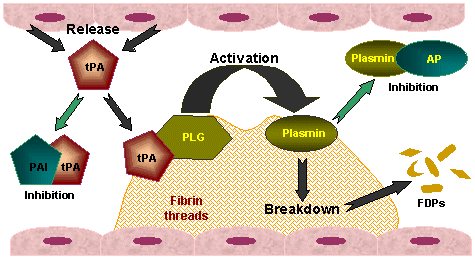Tertiary Hemostasis
|
Tertiary hemostasis is defined as the formation of plasmin, which is the main enzyme responsible for fibrinolysis (breakdown of the clot).
At the same time as the coagulation cascade is activated, tissue plasminogen activator (tPA) is released from endothelial cells. Release is stimulated by a variety of factors, including hypoxia and bradykinin. Tissue plasminogen activator binds to plasminogen within the clot, converting it into plasmin. Plasmin lyses both fibrinogen and fibrin (soluble and crosslinked) in the clot, releasing fibrin(ogen) degradation products. This process is outlined in the image below, which also illustrates the inhibitors of the fibrinolytic pathway (antiplasmin and plasminogen activator inhibitor).
|
 Abbreviations: tPA: tissue plasminogen activator; PAI: plasminogen activator inhibitor; PLG: Plasminogen; AP: Antiplasmin; FDPs: Fibrin(ogen) degradation products.
Abbreviations: tPA: tissue plasminogen activator; PAI: plasminogen activator inhibitor; PLG: Plasminogen; AP: Antiplasmin; FDPs: Fibrin(ogen) degradation products.
|
The activation of plasminogen by tPA requires fibrin, thus limiting the production of plasmin to the site of thrombus formation. This localization of plasmin is important, since it is fairly non-specific in its activity and will not only destroy fibrin, but also other factors, including factors V and VIII and fibrinogen.
There are other plasminogen activators independent of tPA. These include urokinase, factor XII and kallikrein. Activated factor XII and kallikrein can activate plasminogen into plasmin directly. Furthermore, factor XII and kallikrein produce bradykinin from high-molecular weight kininogen in the contact portion of the intrinsic pathway of coagulation; bradykinin being the most specific and potent stimulus for tPA release. This emphasizes the role of the early components of the intrinsic pathway (high-molecular weight kininogen, prekallikrein and factor XII) in fibrinolysis and bradykinin generation rather than coagulation.
|